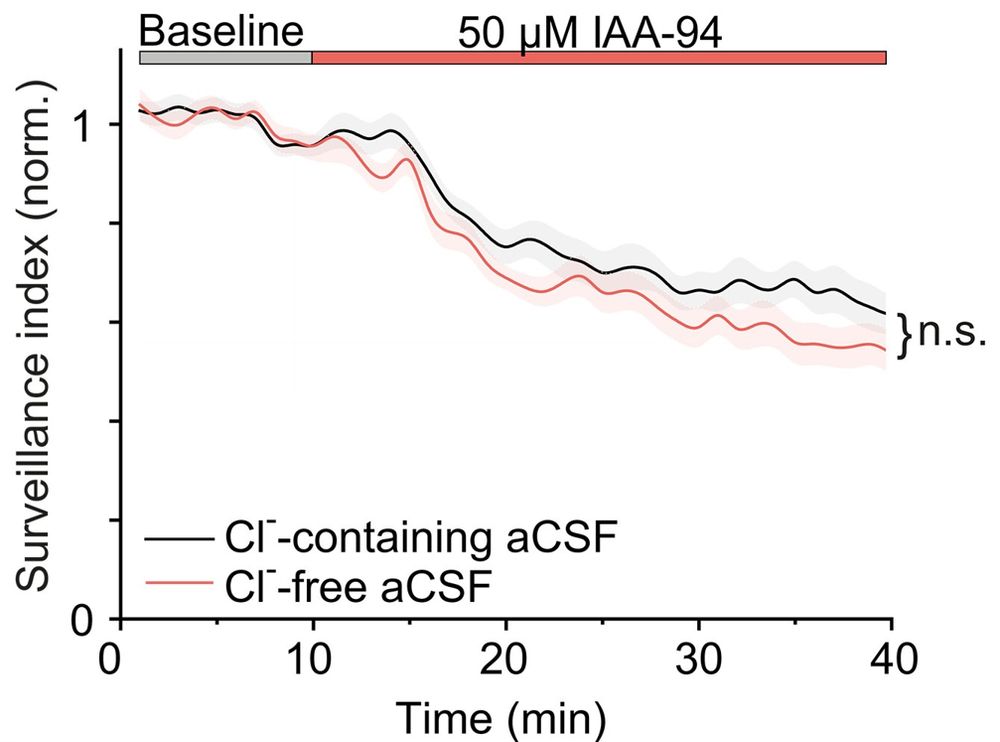
This study reflects the dedication of a great team over many years. I am sincerely thankful to my co-first author Tom Bickel, to our PI Christian Madry and to all collaborators who brought their expertise and care to this work.
Read the full story here: www.science.org/doi/10.1126/...
25.10.2025 15:21 — 👍 2 🔁 1 💬 0 📌 0
In summary, we could show that CLIC1 regulates microglial morphodynamics and inflammation across species, through a non-canonical, ion channel independent mechanism. Given its high enrichment in microglia, CLIC1 could be a potential target to contain neuroinflammation.
25.10.2025 15:21 — 👍 0 🔁 0 💬 1 📌 0

Finally, we asked whether these mechanisms translate to human microglia. Using a mouse model with xenotransplanted human microglia and human brain tissue, we confirmed that CLIC1 regulates microglial morphodynamics and inflammatory signaling across species.
25.10.2025 15:21 — 👍 2 🔁 0 💬 1 📌 0
CLIC1 turned out to influence not only process motility but also inflammation. Inhibiting CLIC1 strongly reduced NLRP3-dependent release of IL-1β. This function was again incompatible with CLIC1 acting as a Cl⁻ channel and was instead governed by its conserved enzymatic activity.
25.10.2025 15:21 — 👍 0 🔁 0 💬 1 📌 0

If not as an ion channel, how does CLIC1 control motility and ramification? CLIC1 can also exist in a soluble cytosolic form. In this state, it interacts with actin and ERM family proteins, and likely serves as a scaffold protein that links the cytoskeleton to the plasma membrane.
25.10.2025 15:21 — 👍 0 🔁 0 💬 1 📌 0

To test if CLIC1 acts as a Cl⁻ channel, we repeated our experiments in Cl⁻-free solutions. Surprisingly, depleting Cl⁻ did not alter the effect of CLIC1 blockade on motility and ramification. So, contrary to its name, CLIC1 does not act as a Cl⁻ channel to regulate this.
25.10.2025 15:21 — 👍 0 🔁 0 💬 1 📌 0
To confirm this genetically, we analyzed a constitutive and a microglia-specific CLIC1 knockout mouse. In both cases, microglia showed reduced process ramification and impaired motility, closely matching the pharmacological phenotype.
25.10.2025 15:21 — 👍 1 🔁 0 💬 1 📌 0

To test wheter our initial effects could be explained by CLIC1, we blocked it using the small molecule IAA94 and an anti-CLIC1 antibody. The result was clear: CLIC1 blockade reduced microglial ramification and process motility, thereby reducing the surveillance of the brain.
25.10.2025 15:21 — 👍 0 🔁 0 💬 1 📌 0

To identify candidate genes, we turned to scRNA sequencing, and found one gene prominently standing out: CLIC1, which encodes the Chloride Intracellular Channel 1. It was highly expressed in both mouse and human microglia but barely detectable in other brain cells.
25.10.2025 15:21 — 👍 0 🔁 0 💬 1 📌 0

In our experiments, broad-spectrum Cl⁻ channel blockers profoundly impaired microglial motility and process ramification. Yet patch-clamp recordings revealed no tonic Cl⁻ conductance in the plasma membrane. We considered two options: either a nonspecific drug effect or an intracellular Cl⁻ channel.
25.10.2025 15:21 — 👍 0 🔁 0 💬 1 📌 0
Microglia are the brain’s most dynamic cells, constantly extending and retracting their processes to monitor the parenchyma and respond to potential danger with inflammatory signaling.
Our new study in @ScienceAdvances @science.org explores how these functions are regulated.
25.10.2025 15:21 — 👍 44 🔁 8 💬 2 📌 0

The chloride intracellular channel 1 (CLIC1) is essential for microglial morphodynamics and neuroinflammation
CLIC1 regulates surveillance, morphology, and interleukin release in mouse and human brain microglia.
Very interesting paper in Science Advances by the Madry lab showing that the chloride channel Clic1 regulates morphodynamics and surveillance of #microglia via ERM proteins. These functions are chloride independent. www.science.org/doi/10.1126/...
22.10.2025 19:37 — 👍 7 🔁 1 💬 0 📌 0
At the junction of optics, neuroscience, ophthalmology and bioengineering.
https://aria.cvs.rochester.edu/our_work/blood_flow.html
PostDoc in Eicke Latz lab @iii Bonn (previously - PhD @brozlab.bsky.social) working on inflammasomes and cell death and their role in inflammation and tissue repair. Passionate about all things #microscopy, #optogenetics and #cycling 🔬🚴🏼♀️.
PhD in Maastricht, microglia and microscopes
Die Alzheimer Forschung Initiative ist ein Verein, der mit Spenden die Alzheimer Forschung unterstützt und die Öffentlichkeit aufklärt.
https://www.alzheimer-forschung.de/impressum
http://www.alzheimer-forschung.de/datenschutz-socialmedia
Professor of Neurology, UT Health San Antonio. Vascular neurology | Neuroscience | Research: stroke recovery, AI, long covid | Cat family | He, him
Postdoc in Talbot Lab at Oxford Motor Neuron Disease Centre @mndoxford.bsky.social and Junior Research Fellow at Kellogg College Oxford @kelloggoxford.bsky.social, using iPSC models to research microglia-motor neuron interactions in ALS/MND.
Clinician Scientist I Neuropathology @ University Clinic of Freiburg | Hem/Onc - Neuroimmunology - Precision medicine | EANO Youngster Committee
Nachrichten aus Pharmazie, Medizin, Gesundheitspolitik und dem Apothekenmarkt.
Wellcome Career Development fellow investigating how the immune system modulates behaviour during chronic challenges
MSc. Neuroscience &MSc.Physiotherapy| Just a researcher, microglia lover |I hope to become a PhD student in neuroscience | Neuroscience, Anatomy & Exercise Physiology
Cell & Neurobiologist. Group Leader & Lecturer at the Institute of Biochemistry, Charité Berlin. Research interest in the actin cytoskeleton and membrane trafficking in astrocytes.
Pharmacologist, Neurophysiologist, Dementia fellow. Studying neuro-glia in circuits. father of a kid. person profile.
Scientist | Collaborative Leadership Consultant for STEM Leaders and Organizations at the BridgUs Lab
Advancing science, serving society.
One of the world’s largest general scientific societies and publisher of @science.org
Postdoc in @liganlab.bluesky.social at Weill Cornell Medicine interested in resilience and microglia in neurodegeneration • Vanderbilt Neuro PhD ‘22 • Kenyon College ‘17 • 1st gen Egyptian-American
Stanford, UTSW, WashU, Emory, UF & now Indiana Uni SOM Stark Neuroscience. Latina, mother, daughter. Immunity inflammation lysosomes neuroimmuno neurodegen, EIC NPJPARKD. Posts my own.
Neuroscientist investigating Alzheimer’s, brain vasculature & tau tangles. @MGH Neurology
Nature Portfolio’s high-quality products and services across the life, physical, chemical and applied sciences is dedicated to serving the scientific community.
neuroscientist, psychiatrist, writer
optogenetics.org
karldeisseroth.org
https://www.amazon.com/Projections-Story-Emotions-Karl-Deisseroth/dp/1984853694
Understanding life. Advancing health.








